|
 The club is composed of many
jumpers, some with more experience than others, but all with a great
knowledge of the sport. Lincoln Daily News recently had the chance
to talk with and observe several dives, as well as take a trip up in
the plane! The club is composed of many
jumpers, some with more experience than others, but all with a great
knowledge of the sport. Lincoln Daily News recently had the chance
to talk with and observe several dives, as well as take a trip up in
the plane!
The IVPC, as previously stated, has been operating out of Logan
County since 1975, but this particular club predates this location.
Before being located in Lincoln, the club operated out of Minier,
Pekin before that, and Taylorville even before that. The IVPC was
founded back in 1963.
Jeff Hayes, one of the more veteran jumpers of the IVPC, was kind
enough to provide this brief history of the club, as well as his
history with it. Hayes has been jumping for several decades and
learned how to skydive from someone at the IVPC back when it was
located in Minier. On his first day, Hayes shared, he performed six
jumps. Hayes just recently completed his 4,000th jump back in April
of this year.
Another member of the club, Chad Donnel, was able to provide some
insight into what the club is like, as well as why it is different
from a skydiving company. The club does offer classes like a
skydiving company, but thatís where the similarities end. According
to Donnel one of the best perks of being a part of a club like this
is that it is not operated like a business. Itís just a group of
people from all walks of life who like skydiving.

Donnel also shared some information on the different types of
skydiving that one can perform. The first is Accelerated Freefall (AFF)
skydiving. In this method, which is the most common in the sport,
according to the United States Parachute Association, you deploy
your own parachute after a specific time in freefall. The second
method, Static Line, is the first of two methods where the skydiver
does not have to pull their own ripcord. The static line is
connected to the aircraft as well as the deployment bag on the
diverís parachute. Once the cord reaches its full extension and is
pulled taught, the deployment bag is pulled from the chute and the
skydiverís parachute deploys. The final method is called Instructor
Assisted Deployment (IAD). This method is like the Static Line
method, but the instructor is the one who plays the ďroleĒ of the
static line. Donnel shared that the IVPC only provides Static Line
training.
Depending on how you would like to jump, solo or tandem (with an
instructor attached), your class before you jump could take anywhere
from 30 minutes to four hours. This, fortunately, only needs to be
completed once. Your paperwork, however, needs to be completed each
time you jump.
On the morning of June 15th, the day LDN was present for the jumps,
there were three separate jumpers. Two of them, James Hayden of
Pekin and Sumanth Viswanathan of Champaign, had previously jumped
before, and so were skydiving solo.
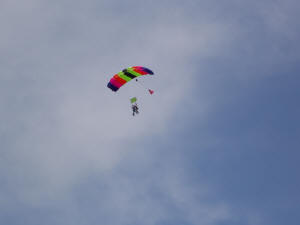
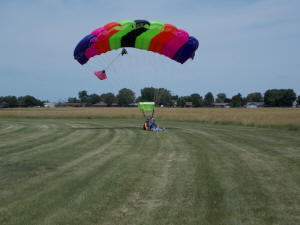
The third jumper, Brandon Jones of Morton, had never
jumped before and was doing so in tandem with Donnel. All three of
the jumpers appeared to have a great time, jumping from varying
heights of 5,500, 8,000, and 11,000 feet up.
[to top of second column]
 |

Before these three jumpers took to the skies,
however, the first jump of the day was performed by several of the
club's more experienced members. These included John Bartis, Dion
Santi, Tonia Royer, and Ian Magerl. Before boarding the plane, they
all got ready in the upstairs room of the club.
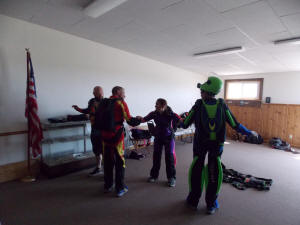

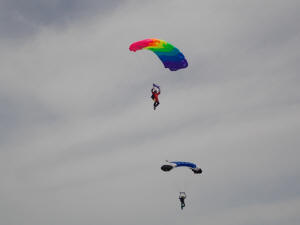
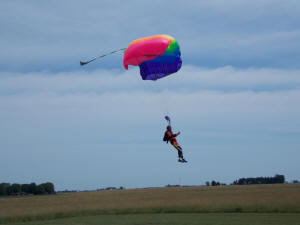
As they were Vertical Formation Skydiving, skydiving
as a group and performing sequences of moves before their chutes
deploy, they took some time to choreograph these moves in advance.
Once on the plane, it took about twenty minutes for it to ascend to
the proper height for the divers to jump. What took twenty minutes
to climb probably lasted less than a minute before their parachutes
were deployed.

With every jumper, once their parachute was deployed, they sailed
back and forth in the air using the steering lines on their
parachute. Hayes shared instructions on how the steering lines
operate. If you pull the left cord, you will steer left for as long
as you are pulling it. If you pull right, you will do the same but
to the right. If both are pulled, it slows you down. Donnel also
shared information on the parachutes the skydivers were wearing. All
of the jumpers have two chutes. The first is one that is either
packed by them (if it is their own gear), and the second one is
packed by a federally licensed parachute packer. This second chute
must be packed by a licensed packer once every six months.
The club was also kind enough to allow LDN reporter Matt Boutcher to
go up in the plane with some of the more experienced divers. Hayes
and Bartis jumped from about 5,000 feet while pilot David Scott
expertly navigated the plane up and back down. While he did not
jump, Boutcher did manage to grab some great shots of Lincoln and
Logan County that you can see in todayís edition of LDN.
If you are interested in learning to skydive, you can learn more
about it and schedule a time to jump by visiting the
IVPCís website here. According to
their website, tandem jumps are available most Saturdays and Sundays
between the months of May and October. Solo jumps are available
throughout the year upon request, although you must be a licensed
jumper to do so. Prices for tandem jumps as well as solo dives can
be found on their website as well.
[Matt Boutcher] |